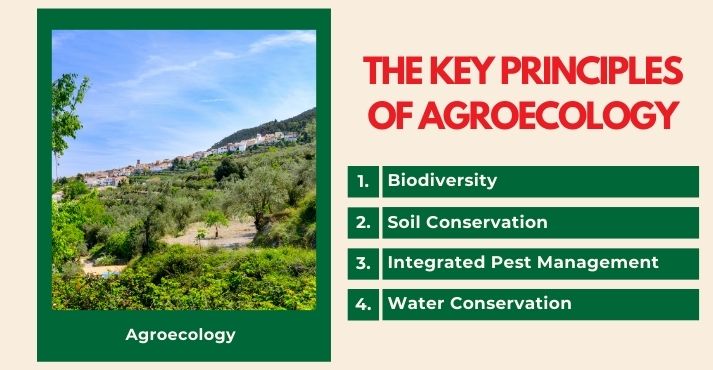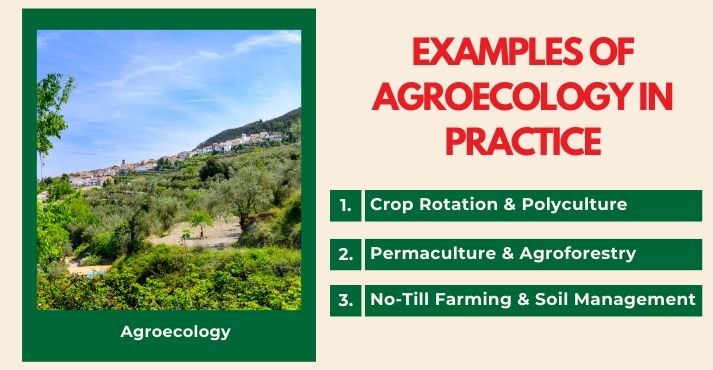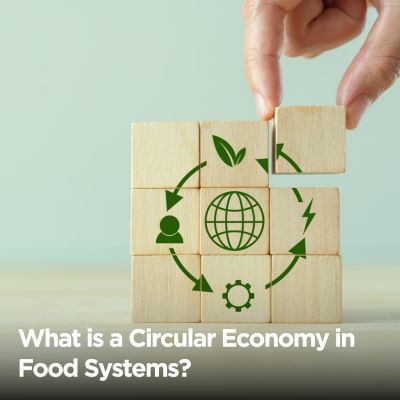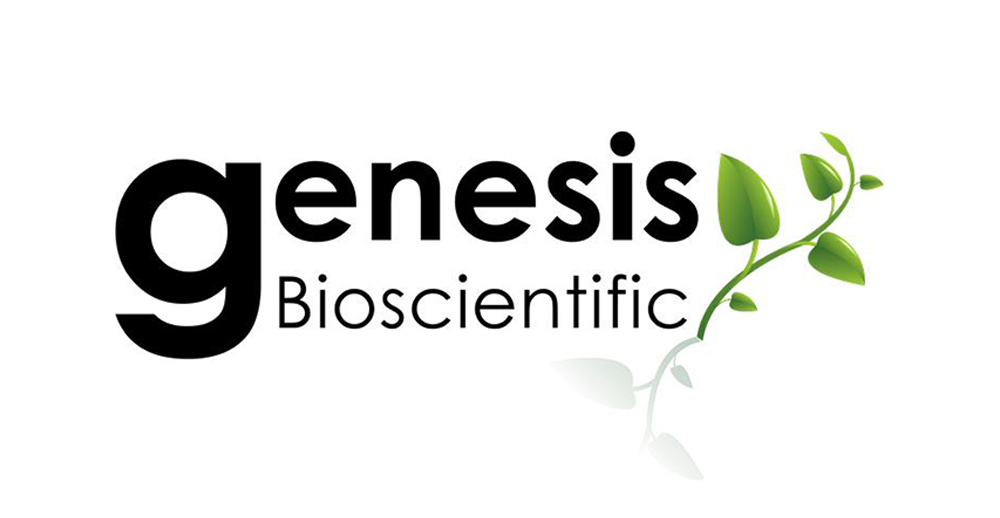Agroecology is a sustainable approach to farming that applies ecological principles to agriculture, creating resilient and productive food systems.
Instead of relying on synthetic fertilizers and pesticides, it focuses on biodiversity, soil health, and natural resource management to improve food production while protecting the environment.
Farmers around the world practice agroecology in different ways, from small-scale crop rotation and composting to larger systems that incorporate agroforestry and natural pest control.
Scientific research combined with traditional farming knowledge helps reduce reliance on chemical inputs, enhance food security, and strengthen rural communities.
In this article, we’ll explore the main principles of agroecology, how it differs from conventional and organic farming, examples, and the benefits and challenges it presents in modern agriculture.
How Agroecology Supports Sustainable Agriculture

Agroecology promotes farming systems that are productive, resilient, and environmentally responsible. It focuses on biodiversity, soil health, and reducing chemical inputs to sustain food production while protecting natural resources.
As a form of ecological farming, it creates a balance between agriculture and the environment, ensuring long-term sustainability.
Biodiversity is essential in agroecology. Instead of relying on monocultures, farmers cultivate a variety of crops and integrate livestock to enhance soil fertility, manage pests naturally, and increase resilience to climate change.
Techniques such as intercropping, crop rotation, and permaculture help maintain ecosystem balance while supporting long-term productivity.
Soil health is another main factor. Agroecology avoids synthetic fertilizers, instead using compost, cover crops, and reduced tillage to maintain soil structure, boost organic matter, and improve water retention.
These sustainable farming methods prevent erosion and maintain long-term land fertility, ensuring that farmland remains productive for future generations.
Minimizing chemical inputs is a fundamental difference between agroecology and conventional farming.
While industrial agriculture depends on synthetic pesticides and fertilizers, agroecology relies on natural solutions like integrated pest management and organic soil amendments. This reduces pollution, preserves beneficial insects, and lowers production costs.
Compared to organic farming, agroecology is not just about eliminating synthetic inputs. It focuses on developing agricultural systems that function like natural ecosystems, integrating scientific knowledge with traditional farming practices.
While organic farming is often governed by certification standards, agroecology takes a more holistic approach, emphasizing land management and community-based solutions to advance sustainable agriculture.
The Key Principles of Agroecology

Agroecology is guided by fundamental principles that promote sustainable and resilient farming systems. These principles ensure that agricultural practices work in harmony with nature while supporting food production, soil health, and resource conservation.
The FAO’s elements of agroecology provide an official framework for implementing these principles in diverse farming systems.
1. Biodiversity:
Biodiversity is a core component of agroecology, ensuring that ecosystems remain resilient and productive. Instead of monoculture farming, agroecological systems integrate multiple crop varieties, livestock, and even trees through agroforestry.
This approach reduces the risk of total crop failure due to pests or climate shocks by diversifying farms.
Farmers around the world use examples of agroecology like intercropping and companion planting to create self-sustaining agricultural systems.
2. Soil Conservation:
Healthy soil is the foundation of productive farming. Agroecology incorporates soil conservation techniques such as cover cropping, crop rotation, and reduced tillage to maintain soil structure, prevent erosion, and boost organic matter.
These methods enhance fertility and improve the soil’s water-holding capacity, making it more resistant to drought. Many of these approaches align with regenerative agriculture, which aims to rebuild soil health by increasing carbon sequestration and microbial biodiversity.
3. Integrated Pest Management:
Agroecology prioritizes natural pest control over chemical pesticides. Integrated pest management (IPM) combines biological control, habitat manipulation, and resistant crop varieties to minimize pest outbreaks.
Beneficial insects like ladybugs and predatory wasps help manage pest populations, while companion planting can deter harmful insects.
This method reduces the need for synthetic chemicals while protecting biodiversity, soil, and water by creating a healthier ecosystem.
4. Water Conservation:
Sustainable water management is essential in agroecology, especially in regions facing drought and water scarcity. Farmers use techniques like rainwater harvesting, drip irrigation, and mulching to retain moisture and reduce evaporation.
These practices improve crop yields and prevent excessive groundwater depletion and soil degradation. By integrating water conservation into farming practices, agroecology ensures long-term sustainability in agriculture.
Examples of Agroecology in Practice

Agroecology is more than a concept; it is a practical approach actively used in sustainable farming worldwide. Its principles helps farmers improve yields, restore soil health, and reduce reliance on synthetic inputs, leading to more resilient and environmentally friendly food systems.
Here are some primary agroecological practices that enhance resilience and sustainability in food production.
Crop Rotation & Polyculture
Crop rotation and polyculture involve growing different crops in sequence or together to improve soil health and reduce pests. This practice prevents nutrient depletion, disrupts pest cycles, and enhances biodiversity.
For example, alternating corn and legumes helps naturally fix nitrogen in the soil, reducing the need for chemical fertilizers. Farmers also use polyculture by planting complementary crops like tomatoes and basil together, which enhances growth and repels pests.
Permaculture & Agroforestry
Permaculture and agroforestry mimic natural ecosystems to create sustainable food systems. These methods integrate trees, crops, and animals to improve biodiversity, soil fertility, and water conservation.
An example is planting fruit trees alongside nitrogen-fixing plants, which enhances soil nutrients while providing shade and habitat for beneficial species. This approach increases food production, helps sequester carbon, and prevents land degradation.
No-Till Farming & Organic Soil Management
No-till farming preserves soil structure by avoiding plowing, which reduces erosion and maintains beneficial microorganisms. Organic soil management further enriches fertility by incorporating compost, green manure, and biofertilizers.
Many farmers use no-till techniques alongside cover crops to retain moisture, suppress weeds, and enhance carbon sequestration. This method is beneficial in dry regions, where it prevents soil degradation and improves long-term agricultural sustainability.
Benefits & Challenges of Agroecology
Agroecology balances farming productivity with environmental care. By applying ecological principles, it creates resilient food systems that benefit both farmers and the planet. However, successful adoption requires policy support and education.
Environmental Benefits
One of the primary agroecology benefits is its positive impact on the environment. It reduces reliance on synthetic fertilizers and pesticides, minimizes pollution, and protects biodiversity.
Practices such as agroforestry and cover cropping improve soil fertility and enhance carbon sequestration, helping mitigate climate change.
Additionally, water conservation techniques, such as rainwater harvesting and no-till farming, reduce soil erosion and improve water retention, making farms more resilient to drought.
According to a UN report on Agroecology & Food Security, more than 90% of crop varieties have disappeared, and half of the breeds of many domestic animals have been lost over the past century.
This biodiversity loss threatens food security, but agroecological practices help restore crop diversity, making agriculture more resilient to climate change and pests.
Economic Benefits
Unlike conventional agriculture, which often depends on costly chemical inputs, agroecology helps farmers cut expenses by using natural processes.
Enhancing soil health and integrating crop diversity can make farms more self-sufficient and less vulnerable to market fluctuations. Over time, these sustainable farming methods can lead to higher yields and increased profitability.
Furthermore, agroecological products often attract consumers seeking sustainable and ethically sourced food, creating new market opportunities.
Challenges in Implementation
Despite its advantages, the transition to agroecology is not without difficulties. Initial adoption may require higher labor inputs and technical knowledge, which can be a barrier for small-scale farmers.
Additionally, many agricultural policies still favor industrial farming models, making it harder for agroecological practices to gain widespread support.
Education and training programs are essential to helping farmers adapt, and governments must implement policies that incentivize the shift toward sustainable agriculture.
Conclusion
Agroecology is a powerful approach to sustainable agriculture. It combines ecological principles with farming practices to create resilient and productive food systems.
By prioritizing biodiversity, soil conservation, and natural resource management, this method helps reduce environmental harm while improving long-term agricultural sustainability.
Real-world examples, such as crop rotation, agroforestry, and no-till farming, demonstrate how agroecology enhances soil fertility, minimizes chemical dependency, and supports regenerative agriculture.
Compared to organic farming, it takes a broader systems-based approach, integrating social, economic, and environmental dimensions.
Agroecology could be a solution to the world’s increasing challenges of food security and climate change. Farmers, policymakers, and consumers all have a role in advancing these practices for a more sustainable and equitable food future.





























